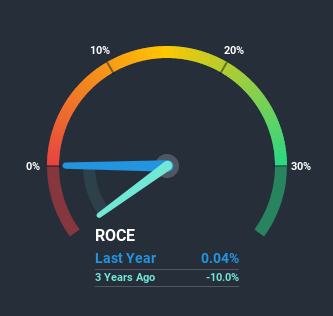Returns On Capital At Comptoir Group (LON:COM) Paint An Interesting Picture

There are a few key trends to look for if we want to identify the next multi-bagger. Typically, we'll want to notice a trend of growing return on capital employed (ROCE) and alongside that, an expanding base of capital employed. Basically this means that a company has profitable initiatives that it can continue to reinvest in, which is a trait of a compounding machine. Although, when we looked at Comptoir Group (LON:COM), it didn't seem to tick all of these boxes.
What is Return On Capital Employed (ROCE)?
If you haven't worked with ROCE before, it measures the 'return' (pre-tax profit) a company generates from capital employed in its business. Analysts use this formula to calculate it for Comptoir Group:
Return on Capital Employed = Earnings Before Interest and Tax (EBIT) ÷ (Total Assets - Current Liabilities)
0.00037 = ج.م150m ÷ (ج.م400b - ج.م169m) (Based on the trailing twelve months to June 2020).
Therefore, Comptoir Group has an ROCE of 0.04%. Ultimately, that's a low return and it under-performs the Hospitality industry average of 6.8%.
View our latest analysis for Comptoir Group
Historical performance is a great place to start when researching a stock so above you can see the gauge for Comptoir Group's ROCE against it's prior returns. If you'd like to look at how Comptoir Group has performed in the past in other metrics, you can view this free graph of past earnings, revenue and cash flow.
What Can We Tell From Comptoir Group's ROCE Trend?
On the surface, the trend of ROCE at Comptoir Group doesn't inspire confidence. Over the last five years, returns on capital have decreased to 0.04% from 25% five years ago. Although, given both revenue and the amount of assets employed in the business have increased, it could suggest the company is investing in growth, and the extra capital has led to a short-term reduction in ROCE. If these investments prove successful, this can bode very well for long term stock performance.
On a side note, Comptoir Group has done well to pay down its current liabilities to 0.04% of total assets. That could partly explain why the ROCE has dropped. What's more, this can reduce some aspects of risk to the business because now the company's suppliers or short-term creditors are funding less of its operations. Since the business is basically funding more of its operations with it's own money, you could argue this has made the business less efficient at generating ROCE.
What We Can Learn From Comptoir Group's ROCE
In summary, despite lower returns in the short term, we're encouraged to see that Comptoir Group is reinvesting for growth and has higher sales as a result. But since the stock has dived 79% in the last three years, there could be other drivers that are influencing the business' outlook. Therefore, we'd suggest researching the stock further to uncover more about the business.
Comptoir Group does come with some risks though, we found 3 warning signs in our investment analysis, and 2 of those make us uncomfortable...
While Comptoir Group may not currently earn the highest returns, we've compiled a list of companies that currently earn more than 25% return on equity. Check out this free list here.
This article by Simply Wall St is general in nature. It does not constitute a recommendation to buy or sell any stock, and does not take account of your objectives, or your financial situation. We aim to bring you long-term focused analysis driven by fundamental data. Note that our analysis may not factor in the latest price-sensitive company announcements or qualitative material. Simply Wall St has no position in any stocks mentioned.
Have feedback on this article? Concerned about the content? Get in touch with us directly. Alternatively, email editorial-team@simplywallst.com.

